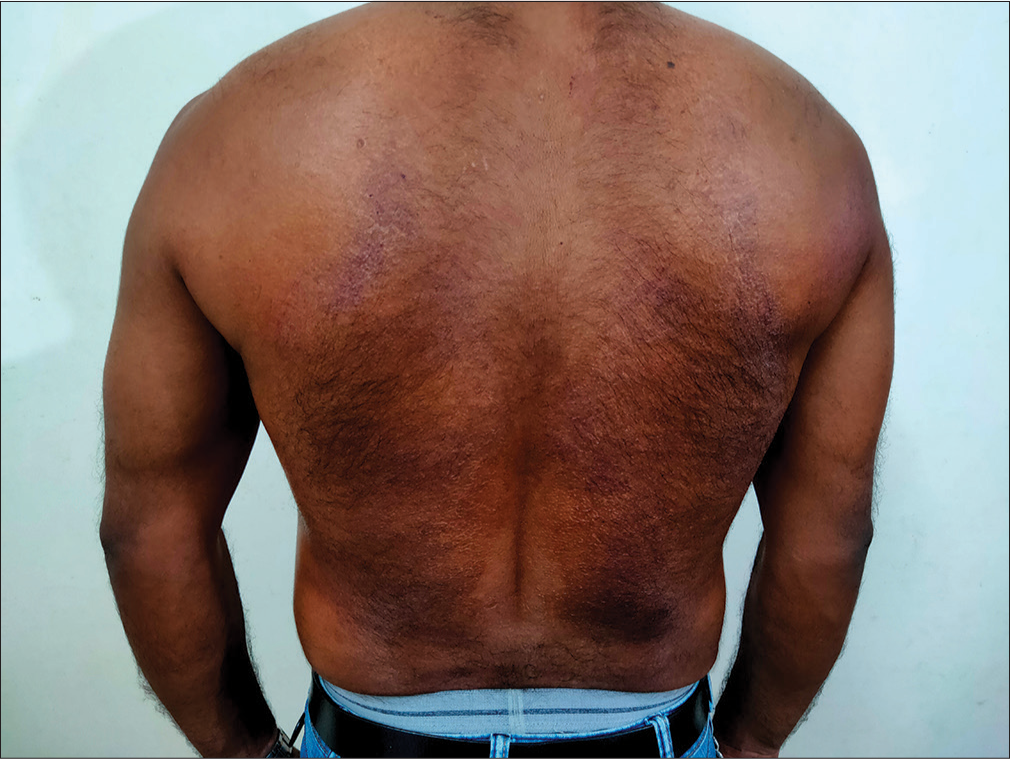Translate this page into:
Hot car seat thermal burn: A must sought for differential diagnosis in summers
*Corresponding author: Nibedita Patro, Department of Dermatology, Venereology & Leprosy, Hi-tech Medical College and Hospital, Bhubaneswar, Odisha, India. nibeditapatro@gmail.com
-
Received: ,
Accepted: ,
How to cite this article: Sitam A, Tripathy P, Patro N. Hot car seat thermal burn: A must sought for differential diagnosis in summers. Indian J Skin Allergy. 2024;3:141-2. doi: 10.25259/IJSA_31_2024
Dear Editor,
Superficial thermal burns cater to a minority of patients in the outpatient department of dermatology. Most of the cases are secondary to hot liquid or hot household object exposure. Superficial thermal burn secondary to a hot car seat exposure has rarely been described in literature and identifying the cause and taking precautionary measures are of utmost importance to prevent further injury.
A 37-year-old male presented to the dermatology outpatient department with pain and a burning sensation on his back for 5 days. On dermatological examination, there was diffuse erythema and fine scaling involving the whole convex surface of the back of the trunk, sparing the midline, in a demarcation perfectly matching the area of contact with the car seat [Figure 1]. The patient described developing similar lesions 1 year back, which were relieved after topical and oral medications. He noticed the symptoms and skin lesions after using the car parked under direct sunlight for 5 hours. No history of any systemic illness or any type of medication was found in the patient. The patient did not give any history of direct sunlight/ultraviolet radiation exposure in the recent past. Allergic contact dermatitis was ruled out as the patient did not give any history of contact with any allergen apart from the hot car seat. The general examination and blood parameters were inconclusive, and a diagnosis of superficial contact thermal burn secondary to exposure to the hot car seat was made considering all environmental circumstances. Sustained exposure to the sunlight causing heating of the car seat and sudden exposure of the skin to the hot car seat even with the garments on led to the development of the typical skin changes in a characteristic distribution. The patient was advised oral corticosteroids (prednisolone 20 mg) for a very short duration (5 days), along with oral antihistamines and topical emollients, resulting in complete resolution of the lesions. He was advised to adhere to the preventive measures like parking the car under a shade, using a shield to cover the seat (preferably cotton cloth) while parking under direct sunlight for a prolonged period, and avoiding sitting suddenly on the seat after placing it under the sun for a long duration. Thermal burns have been divided into superficial (First degree), partial thickness (Second degree), and full thickness (Third degree).[1] Superficial burns (sunburn) involving the epidermis present as an ill-defined area of blanching erythema, soft and warm on palpation. Contact with hot surfaces, hot liquid, superheated gas, or flame may lead to partial-thickness or full-thickness burns involving the epidermis and dermis. Partial-thickness burns present with well to ill-defined blanching erythema and blistering, which is soft and painful on touch, whereas, full-thickness burns present with erythematous to hyperpigmented charred skin that feels firm and leathery on palpation.

- Diffuse erythema & and scaling in a patterned distribution on the convex surface of the back, sparing the midline & and upper back laterally towards the shoulder, coinciding with the area of contact with the car seat.
Car seats are made up of polypropylene (plastic material), which melts at around 160° C.[2,3] The sun’s radiation can increase the temperature inside a car to around 90° C. Therefore, on a hot sunny day in summer, the temperature of the car seat can rise to 100°0 C with prolonged direct exposure to sun rays, which is sufficient to sustain a thermal burn injury to the skin in contact with the surface.[2] There are reports in the literature of deeper degree burns following contact with a hot car seat, especially in infants and patients with paraplegia.[2,4,5]
The management of superficial thermal burns includes immediate cooling with cold water bags, topical soothing agents such as aloe vera, topical corticosteroids, and cool colloidal oatmeal baths. Depending on the severity of the pain, pain can be managed with oral non-steroidal anti-inflammatory agents or intravenous opioids.
Preventive measures such as the use of an appropriate car seat, covering the car seat with cotton cloth, parking in the shade, and avoiding sudden contact with the car seat after prolonged exposure of the car to direct sunlight, are advisable.[6]
Identification of a superficial thermal burn secondary to environmental exposure to a hot car seat is of paramount importance in a busy outpatient department during the hot summer climate to avoid unnecessary investigations and initiate early management.
Ethical approval
The Institutional Review Board approval is not required.
Declaration of patient consent
The authors certify that they have obtained all appropriate patient consent.
Conflicts of interest
There are no conflicts of interest.
Use of artificial intelligence (AI)-assisted technology for manuscript preparation
The authors confirm that there was no use of artificial intelligence (AI)-assisted technology for assisting in the writing or editing of the manuscript and no images were manipulated using AI.
Financial support and sponsorship
Nil.
References
- Burn evaluation and management In: Stat Pearls. Treasure Island, FL: StatPearls Publishing; 2024.
- [Google Scholar]
- Burn injury from car seat in an 11-month-old infant. Pediatr Child Health. 2012;17:495-7.
- [CrossRef] [PubMed] [Google Scholar]
- Polypropylene. The free encyclopedia. Available from: https://en.wikipedia.org/w/index.php?title=Polypropylene&oldid=1225027817 [Last accessed on 2024 May 22]
- [Google Scholar]
- Skin barrier function in infants: Update and outlook. Pharmaceutics. 2022;14:433.
- [CrossRef] [PubMed] [Google Scholar]
- Burn from car seat heater in a man with paraplegia: Case report. J Spinal Cord Med. 2011;34:332-4.
- [CrossRef] [PubMed] [Google Scholar]
- Study on the thermal accumulation and distribution inside a parked car cabin. Am J Appl Sci. 2010;7:784-9.
- [CrossRef] [Google Scholar]





